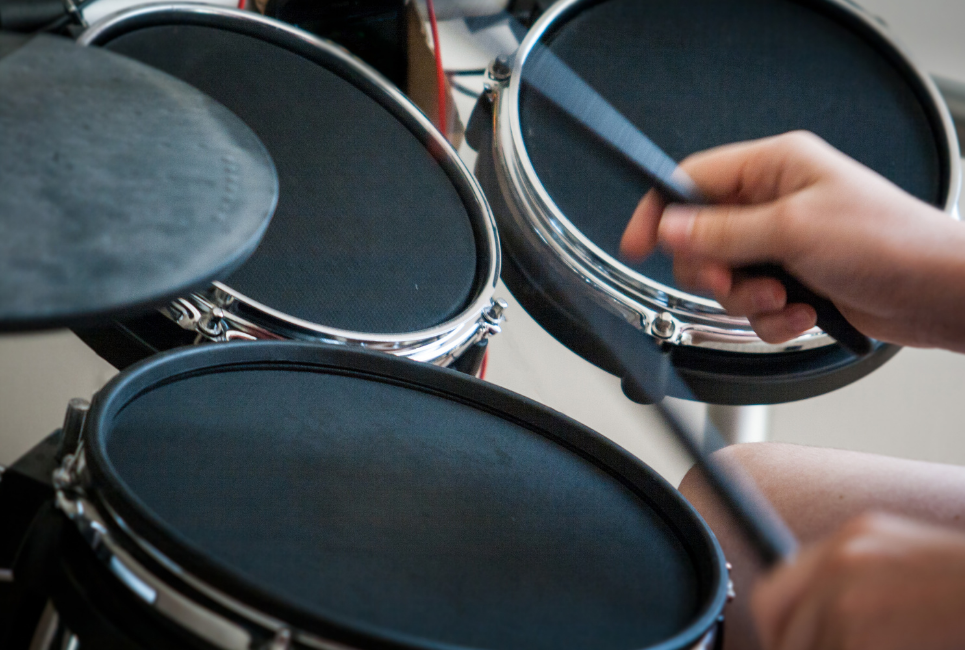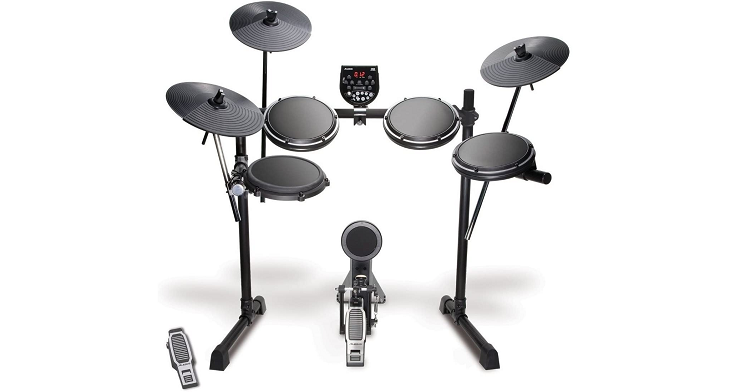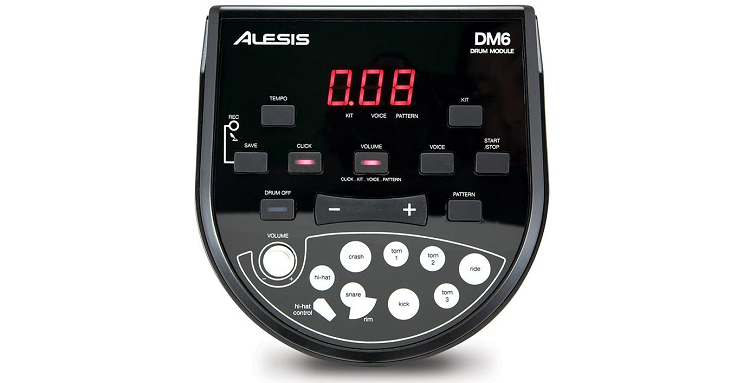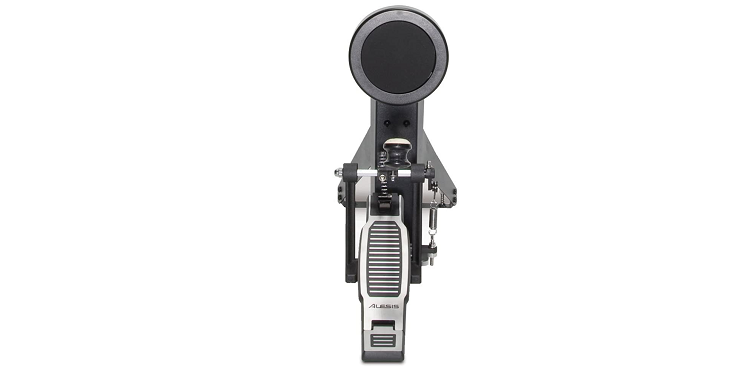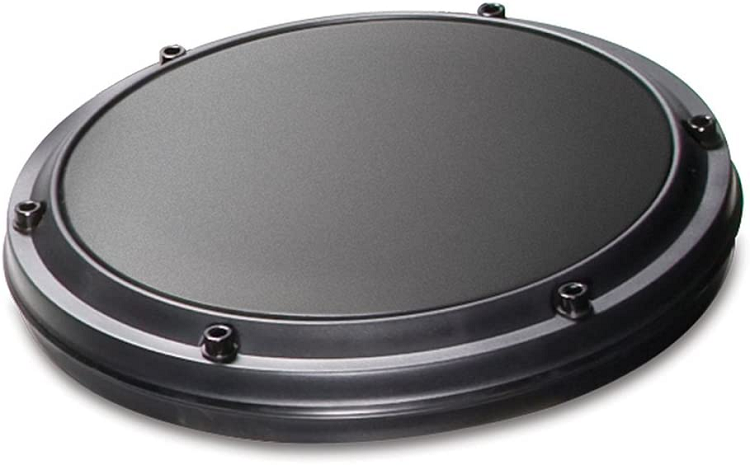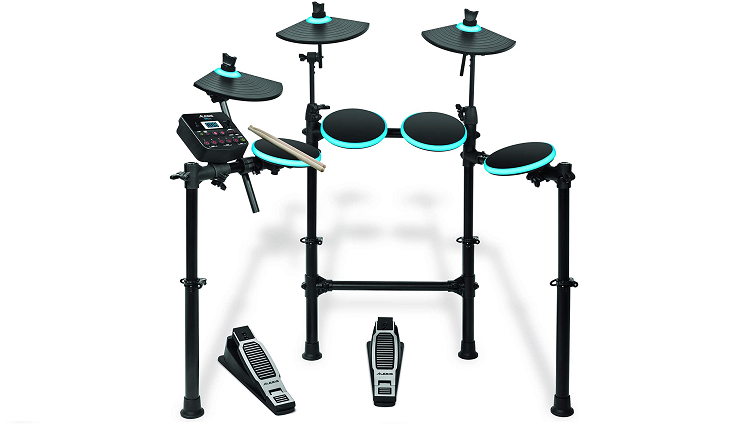- Lights, Camera, and Action: How to Film and Edit a Drum Cover - May 31, 2022
- The Best Wuhan Cymbals: A Comprehensive Buying Guide - May 30, 2022
- Alesis Surge vs Command Compared - April 26, 2022
These days, electronic drums have become a staple in electronic music, in addition to many other types of fusion genres. A lot of drummers who would otherwise play mainly on acoustic drums are also trying their hands on electronic drums these days.
This is a legitimate, fundamental building tool for drummers who like experimenting with a diverse range of ideas.
One could say that the benefits of electronic drum kits outweigh their cons by a significant margin. This is why they quickly garnered a legion of loyal fans who will swear by their trusty digital kits any day. The appeal of various digital features and ergonomic design elements is gravitating many drummers towards electronic drums.
We have some great options for both beginner and expert drummers in the market when it comes to electronic drum kits. The cost of these kits is driven by a few key factors, which is something that I will be discussing in detail. Factors like drum modules, as well as the size and type of drum heads, are only the tip of the iceberg.
If you are a beginner doing your own research, you are likely to find yourself inundated with reviews and speculations from all over the drumming community. This is why it’s so important to keep your eye on the ball. You want to get a drum kit that encompasses your needs and fits your budget comfortably.
There is no doubt that the Alesis DM6 is one of the top rivals in the budget electronic drums category. But how it got there is definitely a very interesting saga. It has received countless positive reviews over the years, and many renowned drummers have greenlit this kit as one of the best for beginners.
How to Pick an Electronic Drum Kit: Some Key Decision-Making Factors
Most drummers, when they think of electronic drums, tend to visualize a compact kit with lots of different drum sounds. It’s true that electronic drums have tons of onboard sounds and modulation effects, but what if you are looking to replace an acoustic kit for practicing at home?
The factors you will consider in this case would vastly differ from a drummer who is trying to expand their vocabulary of sounds.
To make sure that you don’t get washed away in a sea of opinions and reviews, I’ve decided to put together an extensive guide for electronic drums. As we all know, the most crucial part of electronic drum kits (or the so-called “brain”) is the drum module.
This module decides how much processing power, range of onboard sounds and effects, and the various other functionalities your drum kit will have.
Apart from the drum module, here are a few more areas that you want to keep in mind when shopping for electronic drums:
- The Trigger Pads (Or Drum Pads)
- The Included Hardware
- The Input and Output Options
- The Available Samples
The Trigger Pads (or Drum Pads)
When it comes to the drum pads in electronic drum kits, it’s more about how they feel and respond, rather than the sound they make when you strike them. Between rubber, plastic, and mesh pads, the choice can vary depending on your needs and preferences.
Low to mid-range electronic drums usually sport single trigger drum pads, which are often enough for a novice player. As you go up the price range, manufacturers start using multiple triggers for each drum head in order to add more nuance. The most advanced drum kits can host an array of sensors, such as the Roland PD-140DS.
Some drummers like the rigid response of plastic pads, whereas others tend to sway towards rubber and mesh pads for a more realistic response. You also want to make sure to get the right size or diameter, that is easier for you to play on. Your accuracy depends a lot on the size of drum pads, so between 8” to 12”, take your pick.
The Included Hardware
Many drummers, often beginners, don’t think about the hardware elements when buying electronic drums. As a result, they end up regretting getting either less or more components than they needed. The type of material used for the main framework is also worth noting, as it will dictate the weight and the life expectancy of the kit.
E-cymbals are not the best by most industry standards, but in an electronic kit, they fit in just fine. Many people complain about their lack of response and depth in the sound. If you want the best performance and sound, though, it’s wise to invest in a third-party high-end cymbal with complex triggers.
These cymbals can distinctly register strikes made on the bow, edge, or bell. Plus, it even lets you choke the cymbals. At the end of the day, you want a kit that has:
- The desired number of cymbals
- A solid kick pedal
- Mounting gear for your equipment (toms, cymbals, or hi-hats)
- A sturdy carry case, if you are planning to move around with your kit
The Input and Output Options
If you are a studio musician or a drummer looking to record their samples directly from the drum kit itself, then you’re in for a treat. Typically all electronic drum kits will come with a standard input and out pair for direct recording through a mixer. You can also connect them to a computer using a sound interface and start recording at the press of a click.
If you like jamming to backing tracks, then you’d want a kit that has an extra ¼” input jack for connecting music players. In case you are looking for multiple connectivity options for live shows and studio recordings, then there are some higher-tier options that cater to those specifications, as well.
The Available Samples
Last, but not least, the main reason that convinced us to get electronic drums are the drum samples. The ability to change your setup from a thumping rock n’ roll kit to a mellow jazz drum machine is simply remarkable.
The latest modules even let you switch between various mics and miking positions, which lets you fine-tune the dynamics and tonal variations of your sound in great detail.
Let’s not forget about those vintage reverbs that can cost a fortune if you went to buy them separately as pedals, either. Between various room settings and types, you’ll be amazed by the capabilities of electronic drum kits.
The choice for the right electronic drum kit essentially boils down to three crucial factors, even though all the above-mentioned factors play a sizable role, which are:
- The Quality of Sound Banks
- The Included Hardware
- Input and Output Options
If you are a drum nerd looking to get into the nitty-gritty of electronic drums, then there is certainly a lot for you to chew on here. Given all the ways you can customize your kit these days, you aren’t going to run out of ideas anytime soon.
With all those decision-making tips out of the way, let’s move to the key features of the Alesis DM6, which help this kit stand out.
The Key Features of the Alesis DM6
Like every other drum kit in its price range, the Alesis DM6 was designed for both beginners and those who don’t want to break the bank.
That said, this might not be the most intelligent pick if you are a professional drummer looking for the best electronic set on the market. However, when it comes to the most bang for your buck, this drum kit shines from every other possible angle.
Alesis had high hopes when they came out with this kit back in 2012. According to them, they went all-in when creating this product and utilized their expertise of twenty years in electronic drum technology to the fullest.
It has all the capabilities, from custom sampling to hooking up your music player, that you’d expect from a standard e-kit.
Alesis is well-known for creating versatile drum kits that don’t compromise on sound quality. The DM6 is a 5-piece compact drum kit that has all-natural rubber surfaces. Right out of the box, you get:
- Ride cymbal pads
- Hi-hat and crash
- Upright kick-drum pad
- A bass drum pedal
- 3 tom pads
- A stand
- 110 volt AC adapter
User Interface and the Alesis DM6 Drum Module
The Alesis DM6’s sound module is very streamlined and user-friendly, which is great for beginners. You have fundamental functions (like volume control and tempo) seamlessly integrated with other functions (like sound banks and voicing control) into an easy-to-understand panel.
At the press of a button, you can:
- Change the volume
- Shuffle between various drum samples
- Edit samples to your preferences
The labels on all of the buttons are clear and easy to read. In terms of voicings, you get 108 different drum sounds that have been sampled from higher quality versions of snares, kick drums, toms, and cymbals.
Alesis has compiled their voicings in ten separate presets (labeled as “rock,” “pop,” “Latin,” and other genres) and also offered you five slots to save your own presets. You also have one-touch access to all your stock and custom presets, which sets the platform for a seamless drumming experience.
Recording Via Computer
This is one of those areas where electronic drum kits take the cake. Recording acoustic drums can be an agonistic process if you want to get the best sound quality. E-kits can act as the middleman between you and your recording device.
If you are recording drums on your computer via a sound interface, you can do this using a MIDI-USB cable. Once plugged into the computer, your DAW (Digital audio workstation) will recognize the device, and you can start recording right away.
Practicing with the Alesis DM6
With electronic drum kits, you can set off in a direction that helps you prioritize your goals while practicing your skills. It’s easy to get lost in the loud cacophony of drums and develop bad habits as a beginner, which is why you should always take assistance from training tools. With the DM6, you get access to:
- A built-in sequencer
- Forty preset music tracks you can play along with
- And a metronome
These training tools will not only introduce you to the various aspects of drumming, but they’ll also help you develop muscle memory and a natural affinity towards timing.
Training tools are an integral part of a drummer’s journey, and it’s impossible to move ahead without them. This is why you should get accustomed to them as early as possible in your journey.
I strongly believe that the main purpose of the Alesis DM6 is to be a practice and training kit, and while it does that job well, it could certainly use some pointers from the training modules that come along with either the Yamaha DTX450K or the Roland TD 11.
Pros
- Even though the DM6 houses an older drum module, it certainly does not feel outdated. It’s still powerful enough for novice players and hobbyists who want to have a good time playing drums at home.
- The Alesis DM6 offers huge value for your money. For less than $500, you get a complete 5-piece drum set, including hardware and drumsticks.
- Even though the drum samples are not top-shelf material, they still sound pretty clear and powerful in the mix. You have 108 drum kits to play around with, which offers a huge creative space for drummers.
- The trigger pads are quite responsive, and they have a relatively wide dynamic range for the price range. Even so, I was having a great time playing ghost strokes, drags, and accents with no extra effort.
- MIDI connectivity expands the potential of this kit to a respectable point, where you are able to record and mix drums only using a computer.
Cons
- For a bit more money, you can get the Nitro Mesh kit, which is a huge upgrade over the DM6. It offers you nearly three times the resources and processing power over its predecessor. Compared to the DM6, the Nitro Mesh has 385 drum kit samples, and 40 presets, which is a huge bump.
- The cymbals are a hit or miss when you are playing fast. They can feel clunky and will often miss notes when playing. This definitely draws the appeal of this kit down because cymbals play a vital role in any drum kit.
- Even though you get 108 drum kit sounds, most of them are simply not that good. I found only a handful of kits that sounded good enough, which made all the other kits nearly redundant.
- Mesh pads have been known to yield better performance, as well as a better feel and response to your strikes. Many drummers are against using rubber pads for this reason. I found them to be a bit stiff and rigid at first glance but figured it might work for warmer tones, such as those used in jazz and reggae.
- The DM6 starts to show its age when you start thinking about features like a looper or an in-built record option. Many other kits in the same price range are offering a few extra features on top of what the DM6 has in store for you.
Some Alternatives I Also Recommend
Alesis Nitro Mesh Kit
The Alesis Nitro Mesh Kit resolves one of the biggest drawbacks that the DM6 has, according to fans, which is by replacing the rubber pads with mesh pads. It’s an 8-piece configuration that hosts over forty drum kits, 385 onboard sounds, and a learning feature for beginners.
The Alesis Nitro Mesh Kit is a marked improvement over its predecessor, which was launched in 2016. It offers more premium features, as well as the quality of life improvement add-ons, for a similarly low price as the DM6. Alesis has drastically expanded the sound library, and its stock presets by increasing their number over three folds.
The Nitro mesh kit comes with a training feature for students, too, which allows you to practice and learn drumming from the comfort of your own bedroom. It also comes with a headphone output jack for practicing silently, which frees you from all restrictions.
The mesh drum heads are a solid choice for electronic drums, which produce a thick sound and realistic hit back. The feel of mesh heads is almost similar to acoustic drums which is why most drummers consider them over rubber drum heads. The kit also comes with extra trigger inputs, just in case you want to add an extra cymbal or tom.
Pros
- Huge sound library and great quality presets
- Mesh heads for optimum feel and performance
- Learning feature is a great asset for new and intermediate drummers
Cons
- Similar to many other models in the price range, the cymbals lack an appropriate amount of feedback and sensitivity
- Price is slightly higher than other beginner models
Yamaha DTX400K
The DTX400K is a worthy rival to the Alesis DM6, as it shines in some areas where the latter fails to deliver. If you can imagine a drum kit that gives you an ample amount of creative and learning opportunities, that’s the Yamaha DTX400K. Although the DTX400K is priced slightly higher than the DM6, the extra investment is totally worth it, in my opinion.
Interestingly, the kit can grow with you as you become a better drummer. You have the capability to expand your drum kit with the extra trigger inputs that come along. This allows you to add a three-zone snare, another crash cymbal, and real pedal action.
The one notable upside to the DTX400K is its rich sound library that includes ten professional-grade drum set samples in one compact kit. The kit is quite lightweight compared to other models and comes with some elements already mounted on the rack.
The drum configuration of the DTX400K is no different than the other models, consisting of five drums, two cymbals, and a hi-hat. Your movement is a bit restricted around the first two tom bars as these are mounted without arms, but the floor tom can be adjusted to fit your preferred place.
All the trigger pads in the DTX400K are single-zone and made from a rubberized material. This may be a turn-off for some drummers, but in my opinion, it isn’t a total deal-breaker. The rubber finish in fact provides a bit of friction to make them stick resilient, but with the help of pressure-sensitive touch, a good response can still be elicited.
Pros
- Affordable and resilient build quality
- Very lightweight and easy to carry
- Cymbals are quite receptive
- Great sound for a kit in this price range
Cons
- Comes with a beaterless kick pedal which can be an ordeal to get familiar with. Rubber pads lack quite a bit of rebound and feel
- Hi-hat pad stays at a fixed distance from the toms, as it’s mounted on a rigid metal rod
Alesis DM Lite
If you are looking for a scaled-down version of the Alesis DM6, then you might want to check out the Alesis DM Lite. This 5-piece kit is a sturdier version of its half-brother that comes with LED lights for better illumination. The kit does however come with one big exception, that it’s pre-assembled from the factory.
All you have to do is unfold, make some height adjustments, and you are good to go. There’s no messing around with the frame once the kit is set up, meaning all the cables are lined up and connected through a single, convenient connection. The kit is comprised of:
- Four drum pads (One snare and three toms, all 7.5” in diameter)
- Three cymbals (A hi-hat, crash, and ride, all 10” in diameter)
- A dynamic kick drum pad
The DM lite module comes with over 200 onboard sounds, thirty tracks to play along to, ten preset drum kits, and a training feature for beginners. You can either use headphones or connect a drum amp to the kit via the ¼” output jack. You also get MIDI connectivity and an input port for plugging in mp3 players.
If you are a metal or rock drummer who wants a thicker kick drum sound, then you’re certainly going to enjoy the dynamic kick pad that comes with this kit. It senses the intensity of your hits and scales the volume of the kick drum accordingly.
This is a great feature for players who want to have more control over the velocity and loudness of their hits.
Alesis also included a pair of drumsticks in the kit, which are decent enough for a beginner, but you may want to consider switching with a better pair in the near future. Apart from the standard metronome, the training feature is what makes the DM lite a solid pick for a starter drum kit.
Pros
- MIDI compatibility
- 200-plus onboard sounds and ten sampled drum kits
- Easy foldable setup for hassle-free travel
- Illuminated drum pads for easier access in dark environments
Cons
- Sound quality is inferior to other models in the same range
- Lacks customization and upgrade options
Frequently Asked Question
Answer: The choice between electronic and acoustic drums really boils down to a player’s preference and the applications you want to use the kit for. E-kits are almost a no-brainer when it comes to dance, hip-hop, R&B, or disco music.
But what’s fascinating is that more and more players are starting to use these kits across a variety of other musical genres too.
In several scenarios, drummers are playing in more than one band and tackling several musical ideas at a given time. If you are one of those drummers, then you know how much of a hassle it could be to change your entire kit every time you have to play a different set.
An electronic drum kit offers you near-realistic drum samples of branded and vintage kits, which you can shuffle through on the same kit itself.
This not only cuts down the time to set up a different kit, but you can directly plug into a mixer and start recording your parts at the press of a single button. Imagine the time you will be saving over the years, which – if you ask me – is better spent on making music.
Also, since most of these kits are super compact and lightweight, it comes as a huge breadth of relief for gigging musicians who are tired of lugging their heavy acoustic kits around different venues.
If you are playing multiple nights a week, consider getting yourself an e-kit, but be careful. You run the very real risk of never wanting to turn back to acoustic drums afterward.
If you are a studio musician working across multiple platforms and applications, then an electronic drum kit might save you a lot of space in the studio. The same goes for musicians who are simply looking for a practice kit at home but are lacking enough space for a gigantic acoustic kit.
Answer: Yes, feel free to swing to your heart’s content with brushes or multi-rod drumsticks! As we have sophisticated trigger pads coming out these days which help you play embellishments and accents with much ease, don’t hold yourself back from experimenting with unconventional ideas.
There is a catch, though. You can find these triggers in mostly high-end kits. High-end drum pads typically come with multiple triggers, as opposed to starter kits that usually fail to capture the dynamics of strokes like rim shots.
Many kits in the Roland’s V-drums TD-25/TD-30/TD-50 range are recommended for brush playing because of their remarkable sensitivity and drum samples. Some e-kits will feature special settings for brush strokes, so if you’re an enthusiast of brush playing, check out Roland’s V-drums series.
Answer: Using a dedicated drum amp is arguably the most economical and organic way of amplifying your electronic drum kit. Then again, if you are aiming for a quieter setup, you might want to switch to a good pair of headphones or in-ear monitors.
In the long run, investing in a solid drum amp will be much more beneficial to you. They also double up as stage monitors for live shows, so that’s a huge plus point for gigging drummers. Plus, you can use them as a playback device for jam tracks or lessons while practicing.
Answer: These numbers refer to the overall circumference or thickness of drum sticks. For instance, a 7A stick is thinner than let’s say 5A or 3A. Depending on the sound and rebond you are looking for, the thickness of the drum sticks will vary.
If you are pursuing a thick sound that’s much preferred in rock and metal music, then you want to go with a thicker stick. On the other hand, if you are a jazz or R&B player, you might want to stick to a thinner stick which is better suited for milder accents and a warm tone, such as a 3A or 4A.
Answer: A guitar amp? Never. But in rare instances, you can get away with a big enough keyboard amp. As some of these amps are designed to go along with onboard drum machines and other percussion sounds on keyboards, they are considered safe to be used with e-kits.
You might not get the best sound, dynamics, or performance with a keyboard amp but if that’s your only option, then there’s no risk in playing with one. Guitar amps, on the other hand, are a completely different story altogether.
They are EQ’d in a vastly different manner compared to drum amps. Guitar amps usually have their mids boosted with some extra sizzle in the top end, which is exactly the opposite of what a drum amp is aiming for. Worst case scenario, you will end up damaging the guitar amp, so refrain from using one with your e-drum kit.
My Final Verdict
I’d like to conclude this review by saying that if the idea of electronic drums excites you, then you should not be sleeping on those instincts. Technology in the field of electronic drums has come far enough to deliver a seamless, and near-realistic acoustic drumming experience without the deafening sound.
Brands like Alesis, Roland, and DW are carrying the torch right now as the creators of the most versatile range of e-drums. Every brand tackles the issues around drum sampling differently, so it’s worth checking them all out before you purchase your next kit.
And with the Alesis DM6 (which I definitely recommend!), you can start making the music you always wanted to create.
And don’t forget: an electronic drum kit is only as good as the amp it’s playing through. So buy yourself a good drum amp to go along with your drum kit. That way, you can get the best value out of your kit in the long run – and you can also continue to make amazing music for years to come!
For more interesting reading on drum gear, check out the following articles that we have here on the site:
- Simmons SD300 Review and Guide – Why Buying a $100 Electronic Drum Set Isn’t a Good Idea
- Alesis SamplePad Pro Review – Good Enough to Compete with Top-Quality Sample Pads?
- Alesis Forge Review and Guide to Picking a Better Kit
- Pearl Emerge Review & Guide 2022 – A Guide to Deciding if it’s the Right Kit for You

